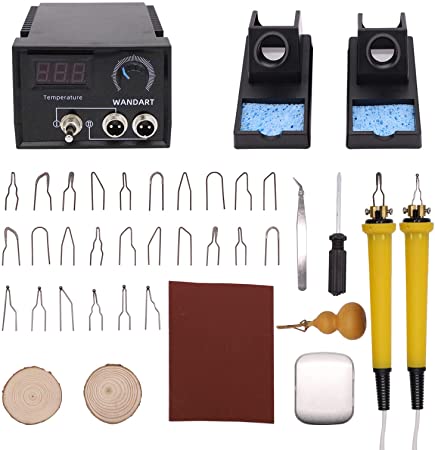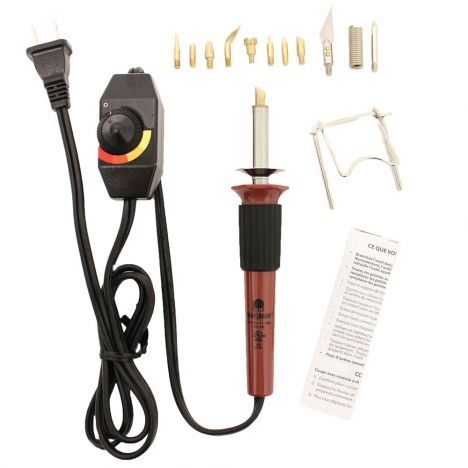
For creating beautiful wood burning projects, a pen with a ball tip for wood burning is a great tool. There are many kinds of pen tips. Each one can produce different temperatures and pressures. The standard pen tip is able to withstand high heat and pressure but the heavier-duty version is more suitable for wood burning. This tip will last for longer than its regular counterpart. The ball tip of a pen will not emit harmful fumes.
Choose the right tip
There are many options for wood burning ball tips. However, not all are created equally. Some tips create a very thin line, while others produce fine lines. Ballpoint pen tips are best for beginners. They are easier to use and can create thicker lines. Some wood burners are more proficient and may prefer finer pen tip options, such as a needlepoint tip. These pen tips are excellent for creating signatures and intricate details, but they can be difficult to control and can damage wood if not used properly.
It is important to select a balltip that will achieve your desired result. The majority of wood-burning tools can be used with a wide range of materials. Below are some tips that will help you to choose the right wood burner ball tip. Wood burning pens have metal wire tips. Either a fixed pen with an attached clip or one that is interchangeable allows you to choose the style of your tip. These are usually more costly and more flexible than the first.
How to choose a wood
It is important to determine the type of wood that you will be burning before choosing a wood-burning ball tip. The Colwood spear-shaped, wood burning tip is great for burning MDF and other soft surfaces. The pointed tip is ideal for drawing details and contouring. It's also an excellent choice for burning large curves. The tip's shape makes it possible to make gentle gradients.
Flexible and durable multi-use wood burning tips can be used in many ways. They come in many sizes, shapes, angles, thicknesses, and shapes. The nibs that are heavier will heat slower, but they are also more durable than regular pen tips. Because they are inexpensive and easily available, beginners can use standard pen tips. They are also good at lower temperatures. You can choose the wood burning ball tip that suits your preference and style.
Choosing a pen

If you're a beginner wood burner, the best tip to use is a rounded ball tip pen. Although smaller tip sizes can be more difficult to control they leave a thicker line which is easier to clean up. However, as you get more experience you can switch to finer-tipped markers. Needle-point pens offer a great solution for small details or signatures but require great control. If you're not careful, you can gouge the wood!
It is important to take into account the shape and dimensions of the nib when selecting a wood burner pen. A smaller tip is better for delicate and detailed work. A larger tip will provide more coverage for bolder and wider designs. You should begin with a wood burning, ball tip pen that can hold all of your tips. The nozzle size should be checked.
Avoid inhaling fumes
Inhaled wood smoke is a source of thousands upon thousands of microscopic particle, including PM2.5 (particles less than 2.5 microns), the most dangerous form. These particles can cause irritation in the eyes and nose, stomach, and lungs. You must keep your fireplace sanitized and prevent inhaling the wood smoke. You can also sign up for air quality alarms.

Wood burning smoke can cause irritations of the eyes and sinuses as well as headaches. It can also lead to reduced lung function, increased symptoms of lung disease, and an increased risk of heart attack. Children and pregnant ladies are at greatest risk due to the fact that their respiratory systems still develop and they inhale greater amounts of air than those who are healthy. Lung and heart disease can be caused by wood smoke, so pregnant women who have been diagnosed with it should take precautions to protect their unborn baby.
Moreover, exposing a home to wood smoke is especially dangerous for elderly and young people, as it contains highly toxic chemicals such as formaldehyde and polycyclic aromatic hydrocarbons. Not only does wood smoke contribute to air pollution, it also contains particulates that can harm the human respiratory system. If you smoke wood, you're exposing yourself to harmful levels of carbon Monoxide.
FAQ
How much should a Woodworker Charge per Hour?
The hourly rate for a professional Woodworker will vary depending on many variables, such as experience, skill level and availability.
An average hourly rate for skilled woodworkers ranges between $20-$50.
A less skilled woodworker can charge as low at $10 an hour.
What woods are suitable for making furniture?
Woods are classified according their hardness. Softwoods include pine, fir, cedar, and cypress. Because they are resistant, they can be used for outdoor furniture. These hardwoods include maple, mahogany and teak. They can't withstand the elements outside so they're best kept indoors.
Can I refinish my own furniture?
Yes! There are many options for refinishing furniture that you don't need to hire a professional. Here are a few ideas:
Sandpaper can be used to remove stains and scratches. After that, use a clean towel to wipe the surface.
Use clear polyurethane varnish. Allow furniture to dry completely before you move it around.
Use acrylic paint to paint furniture.
Use stain instead of paint. Furniture will look richer with the stain.
Use shellac wax. The wax will add shine to the wood and protect it.
What material would your recommendation be to learn woodworking?
Start with softwood like pine, poplar and ash. You will feel more comfortable with these softwoods, so you can move onto hardwood.
Statistics
- In 2014, there were just over 237,000 jobs for all woodworkers, with other wood product manufacturing employing 23 percent; wood kitchen cabinets and countertop manufacturing employing 21 percent. (theartcareerproject.com)
- The best-paid 10 percent make $76,000, while the lowest-paid 10 percent make $34,000. (zippia.com)
- Woodworkers on the lower end of that spectrum, the bottom 10% to be exact, make roughly $24,000 a year, while the top 10% makes $108,000. (zippia.com)
- The U.S. Bureau of Labor Statistics (BLS) estimates that the number of jobs for woodworkers will decline by 4% between 2019 and 2029. (indeed.com)
External Links
How To
Tips for driving a nail in wood
To drive a nail into wood, the first step is to select the right size and type hammer. The most commonly used types of Hammers are claw hammers. Each type of hammer comes with its advantages and disadvantages. A claw hammer works well when you're trying to hit nails with a heavy hammer. However it is difficult to precisely control where the blow hits. A sledgehammer allows you to hit large areas simultaneously, but it is too heavy and cumbersome to use for small tasks.
After selecting the right hammer, you will need to place your hand flat against one side of the head. The handle should rest comfortably in your hands. Grip the handle firmly, but don't squeeze it so tightly that you hurt yourself. You should hold the hammer straight-up, with your wrist still relaxed. Then swing the hammer back toward the ground, aiming for the center of the nail. The impact of the hammer hitting the nail should be felt. Try practicing with a block to help you master the art of swinging a stick.
When you're ready to start driving the nail, hold the hammer in front of you close to your body. Place the nail so that it is perpendicular with the wood's surface. Keep your attention on the tip. Swing the hammer forward, then follow through with the motion of the hammerhead. Keep doing this until you are comfortable with the swing. Once you've mastered the technique, try adding power to your swings. To make it more powerful, hold the hammer up high to your shoulder and then bring it down. This way, you'll be able to put more energy behind your blows.
Once you've made the first nail hole, take out the hammer. Use a pry bar or screwdriver to pull out the rest of the nails. To prevent splitting the wood, ensure you keep the nail heads flush against the board's surface.